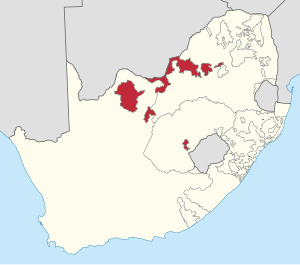| 1994 Bophuthatswana crisis | |||||||||
|---|---|---|---|---|---|---|---|---|---|
| Part of the internal resistance to apartheid and the negotiations to end apartheid in South Africa | |||||||||
 Map of Bophuthatswana (red) within South Africa. | |||||||||
| |||||||||
| Belligerents | |||||||||
|
| |||||||||
| Commanders and leaders | |||||||||
|
| Unknown | ||||||||
| Strength | |||||||||
|
|
| ||||||||
| Casualties and losses | |||||||||
|
Volksfront: 1 killed[4] AWB: 4 killed, 11 wounded[5][4] | BDF: None[4] | ||||||||
| 67 civilians killed, hundreds wounded[6] | |||||||||
The 1994 Bophuthatswana crisis was a major political crisis which began after Lucas Mangope, the president of Bophuthatswana, a nominally independent South African bantustan created under apartheid, attempted to crush widespread labour unrest and popular demonstrations demanding the incorporation of the territory into South Africa pending non-racial elections later that year.[7] Violent protests immediately broke out following President Mangope's announcement on 7 March that Bophuthatswana would boycott the South African general elections.[8] This was escalated by the arrival of right-wing Afrikaner militias seeking to preserve the Mangope government. The predominantly black Bophuthatswana Defence Force and police refused to cooperate with the white extremists and mutinied, then forced the Afrikaner militias to leave Bophuthatswana.[9] The South African military entered Bophuthatswana and restored order on 12 March.[8]
The Bophuthatswana Crisis highlighted the deep unpopularity of the Mangope government and the bantustan system among most of the residents.[9] It has been remembered largely for the televised execution of three Afrikaner Weerstandsbeweging (AWB) militants by a black police officer, Ontlametse Bernstein Menyatsoe. This proved to be a public relations disaster for the AWB and demoralised the movement, which was then intent on preserving white minority rule.[10]
- ^ Allister Sparks (July 1996). Tomorrow Is Another Country: The Inside Story of South Africa's Road to Change (1996 ed.). University of Chicago Press. pp. 206–218. ISBN 978-0226768557.
- ^ "Truth Commission - Special Report - TRC Final Report - Volume 2, Section 1, Chapter". sabctrc.saha.org.za.
- ^ "Executions Underscore Bophuthatswana Chaos". Los Angeles Times. 12 March 1994.
- ^ a b c THE DEATHS IN THE MMABATHO/MAFIKENG AREA Archived 3 March 2016 at the Wayback Machine
- ^ Jeffrey, Anthea (15 May 2019). People's War. Jonathan Ball Publishers. ISBN 9781868429974.
- ^ "WHITES, TROOPS CLASH IN BLACK 'HOMELAND'". washingtonpost.com.
- ^ Lentz, Harris (1996). Heads of States and Governments Since 1945. Abingdon: Routledge Books. pp. 100–101. ISBN 978-1884964442.
- ^ a b Appiah, Kwame; Gates, Henry Louis (2010). Encyclopedia of Africa. Oxford: Oxford University Press. pp. 195–196. ISBN 978-0195337709.
- ^ a b Cawthra, Gavin (1997). Securing South Africa's Democracy: Defence, Development and Security in Transition. Basingstoke: Palgrave-Macmillan. p. 79. ISBN 978-0312174194.
- ^ Forging Democracy From Below: Insurgent Transitions in South Africa and El Salvador by Elizabeth Wood, (Cambridge Studies in Comparative Politics) Cambridge University Press 2003